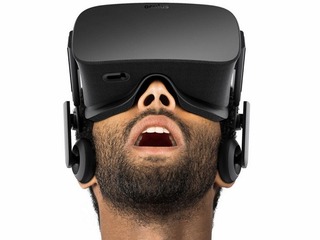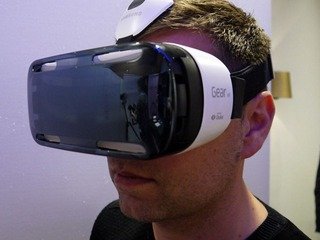
Editor’s Note: Our annual Vator Splash Spring 2016 conference is around the corner on May 12, 2016 at the historic Scottish Rite Center in Oakland. Speakers include Nigel Eccles (CEO & Co-founder, FanDuel), Andy Dunn (Founder & CEO, Bonobos), Mitch Kapor (Founder, Kapor Center for Social Impact); Founders of NextDoor, Handy, TubeMogul; Investors from Khosla Ventures, Javelin Venture Partners, Kapor Capital, Greylock, DFJ, IDG, IVP and more. Join us! REGISTER HERE.
When the Oculus Rift finally came out late last month, many reviews said the same thing: while the technology is pretty great, it’s also very expensive, with each device costing the consumer $600.
The price is likely going to keep sales down this year, according to data out from Strategy Analytics about the virtual reality headset space this year, as consumers will be more willing to go with lower-cost options first.
In all, revenue from these headsets will reach almost $1 billion this year, hitting $895 million, the company found, with a total of the 12.8 million devices that will be sold.
A huge amount of that revenue, 77 percent of it, is going to come from the high end market, specifically from Oculus, as well as HTC and Sony. However the vast majority of the devices that will be sold are going to be on the lower end of the price scale. Only 13 percent, or 1.7 million, will be from those premium devices.
The problem is going to be the high price.
“Adoption of the more expensive, high-end PC and Game Console based devices will be limited to a subset of early adopter enthusiasts and hard core gamers. The high price of these devices will act as a significant barrier to more widespread uptake,” David Watkins, Director of Strategy Analytics’ Connected Home Devices service, said in a statement.
The other commons criticism of the Oculus Rift was its limited scope right now, as it only caters to gamers.
“Oculus Rift is the 2016 product you hope your neighbor buys. You’ll definitely want to try it, but there’s little reason to own one unless you’re a serious gamer. I’m not talking about Candy Crush addicts, or even most of us with a PlayStation at home. Oculus Rift only works with high-end gaming PCs—the recommended Asus model I tested costs $1,449 and requires not one but two power plugs. No Macs will do,” Geoffrey Fowler, The Wall Street Journal wrote in his review of the device, for example.
That issue is reflect in the breakdown of the type of devices that will be sold in 2016. While smartphone-based headsets will make up the most volume, with 87 percent, the most revenue is going to come from the game console based headets, like Oculus, with 46 percent.

“The PC and Console powered virtual reality market is entering the classic chicken and egg phase whereby the major games publishers are waiting on the side-lines until there are enough VR headsets and users in the market for it to make financial sense for them to build a VR library of content,” said Watkins.
“This is providing independent and niche developers the chance to make a name for themselves before the big boys arrive.”
The VR software space
It’s not just VR hardware that is going to see big numbers this year, but software as well.
In just the first two months of this year, the augmented reality, and virtual reality, sectors combined to raise a total of $1.1 billion, up 67 percent from 2015. The space had not raised over $1 billion in a full year before this, forget about in just a couple of months.
In all of 2015, AR and VR startups raised $658 million. And in 2014, $771 million was raised, though $542 million, or 82 percent of the investments made, went into Magic Leap.
In like vein, 2016 numbers are a bit skewed as well, with 72 percent of the amount raised, or a whopping $793.5 million raised, was due to Magic Leap, again.
The two spaces, together, are expected to be worth $150 million by 2020, up from what looks to be around $5 billion this year.
(Image source: techinsider.io)
When the Oculus Rift finally came out late last month, many reviews said the same thing: while the technology is pretty great, it’s also very expensive, with each device costing the consumer $600.
The price is likely going to keep sales down this year, according to data out from Strategy Analytics about the virtual reality headset space this year, as consumers will be more willing to go with lower-cost options first.
In all, revenue from these headsets will reach almost $1 billion this year, hitting $895 million, the company found, with a total of the 12.8 million devices that will be sold.
A huge amount of that revenue, 77 percent of it, is going to come from the high end market, specifically from Oculus, as well as HTC and Sony. However the vast majority of the devices that will be sold are going to be on the lower end of the price scale. Only 13 percent, or 1.7 million, will be from those premium devices.
The problem is going to be the high price.
“Adoption of the more expensive, high-end PC and Game Console based devices will be limited to a subset of early adopter enthusiasts and hard core gamers. The high price of these devices will act as a significant barrier to more widespread uptake,” David Watkins, Director of Strategy Analytics’ Connected Home Devices service, said in a statement.
The other commons criticism of the Oculus Rift was its limited scope right now, as it only caters to gamers.
“Oculus Rift is the 2016 product you hope your neighbor buys. You’ll definitely want to try it, but there’s little reason to own one unless you’re a serious gamer. I’m not talking about Candy Crush addicts, or even most of us with a PlayStation at home. Oculus Rift only works with high-end gaming PCs—the recommended Asus model I tested costs $1,449 and requires not one but two power plugs. No Macs will do,” Geoffrey Fowler, The Wall Street Journal wrote in his review of the device, for example.
That issue is reflect in the breakdown of the type of devices that will be sold in 2016. While smartphone-based headsets will make up the most volume, with 87 percent, the most revenue is going to come from the game console based headets, like Oculus, with 46 percent.



















